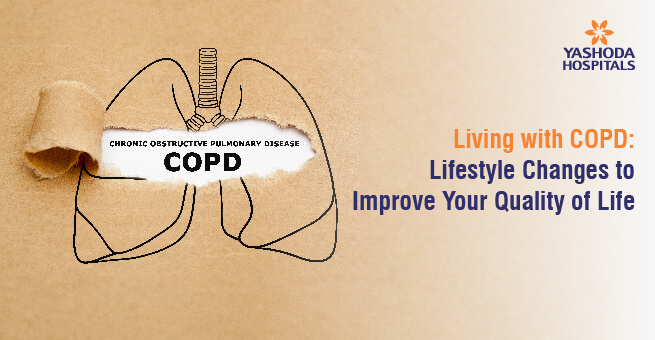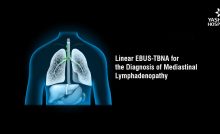

As COPD (Chronic Obstructive Pulmonary Disease) advances, everyday tasks become challenging, mainly due to breathlessness. Coping with COPD may impact your emotional well-being, leading to feelings of sadness, fear, or worry. While these are common responses to a serious illness, persistent or worsening feelings hindering your routine and happy life might indicate symptoms of anxiety or depression.
COPD is a progressive lung condition that affects millions of people worldwide. It encompasses a group of lung diseases, including chronic bronchitis and emphysema, which cause breathing difficulties due to narrowed airways and damage to the lungs. As per the World Health Organization (WHO), Chronic obstructive pulmonary disease (COPD) is the third leading cause of death. Living with COPD can be challenging, but with the right lifestyle changes and access to health education for COPD patients, you can significantly improve your quality of life.
Understanding COPD and its causes
Before delving into lifestyle changes, it’s essential to understand what COPD is and how it affects the body. COPD is characterized by symptoms such as coughing, excessive mucus production, shortness of breath, and reduced lung function. These symptoms can make everyday activities like walking, climbing stairs, and even breathing more difficult.
What is COPD?
COPD is a term used to describe a group of progressive lung diseases, primarily chronic bronchitis, and emphysema, characterized by airflow obstruction that makes breathing difficult. It’s a chronic condition that tends to worsen over time, causing a significant impact on an individual’s quality of life.
Causes of COPD
COPD is primarily caused by long-term exposure to irritating gases or particulate matter, most commonly from cigarette smoke. However, it can also result from prolonged exposure to workplace dust, chemicals, and indoor pollutants, such as secondhand smoke.
Risk Factors & Symptoms of COPD
- Smoking: Smoking is the most significant risk factor for COPD. Current or former smokers are at a much higher risk than non-smokers.
- Occupational Exposure: People who work in jobs with exposure to dust, fumes, or chemicals may be at an increased risk.
- Genetics: A rare genetic condition called alpha-1 antitrypsin deficiency can predispose individuals to COPD
Symptoms of COPD
- Shortness of breath, especially during physical activity
- Chronic cough with mucus production
- Wheezing
- Chest tightness
- Frequent respiratory infections
- Fatigue
- Unintended weight loss
Feel the symptoms of COPD? Take charge—explore lifestyle changes and consult for a healthier life.
Obstructive vs. Restrictive Lung Disease
Understanding the difference between obstructive and restrictive lung diseases is vital for accurate diagnosis and appropriate treatment:
- Obstructive Lung Diseases: Conditions like COPD, asthma, and bronchiectasis involve obstruction or narrowing of the airways, making it difficult to exhale air. This leads to symptoms such as wheezing and shortness of breath.
- Restrictive Lung Diseases: Diseases like interstitial lung disease and sarcoidosis limit the expansion of the lungs, reducing the ability to inhale air fully. This results in reduced lung capacity and breathing difficulties.
Diagnosis for COPD
COPD can often be diagnosed through a combination of medical history, physical examinations, and lung function tests. Pulmonary function tests (PFTs) like spirometry are commonly used to measure lung function and diagnose COPD. Imaging studies, such as chest X-rays and CT scans, may also be employed to assess the extent of lung damage.
Regular monitoring of COPD is essential, and X-rays can provide valuable insights. Changes in X-rays can indicate disease progression, complications, or other lung conditions. In Increased Lung Hyperinflation, we can see increased lung size and a flattened diaphragm on X-rays, indicating air trapping and reduced lung function. Whereas, infiltrates or opacities on the X-ray may suggest respiratory infections that require prompt treatment.
Navigating the Evolving Landscape of COPD Treatment
In the dynamic landscape of COPD treatment, two remarkable advancements offer new hope and transformative possibilities. Explore the innovative realm of BTVA (Bronchoscopic Thermal Vapor Ablation), a targeted therapy using thermal energy to address damaged lung tissue, and lung transplantation, a life-changing procedure that holds the promise of improved quality of life for those with advanced stages of COPD.
BTVA (Bronchoscopic Thermal Vapor Ablation):
- Innovative Approach: BTVA is a novel therapy that involves using thermal energy to target and reduce damaged lung tissue in COPD patients.
- Procedure: Unlike traditional treatments, BTVA is performed through a bronchoscope, minimizing invasiveness and promoting quicker recovery.
- Benefits: Studies suggest that BTVA may provide symptomatic relief and improve lung function in select COPD cases.
- Ongoing Research: As BTVA is a relatively new therapy, ongoing research is crucial to understand its long-term effectiveness and potential applications fully.
Lung Transplantation:
- Last Resort: Lung transplantation is considered a last resort for severe COPD cases when other treatments have failed.
- Criteria for Transplant: Patients must meet specific criteria, including advanced COPD, significant impairment in daily life, and limited response to other therapies.
- Challenges: While lung transplantation can offer a new lease on life, it comes with challenges such as donor shortages, rejection risks, and the need for lifelong immunosuppression.
- Improving Quality of Life: Successful lung transplants have been shown to significantly improve the quality of life for COPD patients, allowing them to resume more normal activities.
Managing and Preventing COPD: Lifestyle Changes for Improved Lung Health
While COPD is a chronic and progressive condition, several lifestyle changes can help you manage your symptoms and improve your overall quality of life:
- Quit Smoking: If you’re a smoker with COPD, the most critical step you can take is to quit smoking immediately. Smoking is the primary cause of COPD and continuing to smoke will only exacerbate your symptoms and speed up the progression of the disease. Seek support from healthcare professionals or smoking cessation programs to increase your chances of successfully quitting.
- Medication Management: Your healthcare provider may prescribe medications to help manage your COPD symptoms, such as bronchodilators and corticosteroids. It’s crucial to take these medications as prescribed and to communicate regularly with your doctor about their effectiveness and any side effects.
- Pulmonary Rehabilitation: Pulmonary rehabilitation programs are designed to improve your lung function, exercise capacity, and overall quality of life. These programs typically include exercise training, breathing techniques, education on COPD management, and psychological support. Participating in pulmonary rehabilitation can significantly enhance your ability to perform daily activities.
- Oxygen Therapy: In some cases, your doctor may prescribe oxygen therapy to ensure your body receives an adequate supply of oxygen. Using oxygen therapy as recommended can alleviate symptoms and enhance your ability to engage in physical activities.
- Stay Active: Regular physical activity is essential for managing COPD. Engaging in exercise can help improve your lung function, reduce breathlessness, and enhance your overall fitness. Consult with your healthcare provider to develop a safe and effective exercise plan tailored to your needs and abilities.
- Nutrition: A well-balanced diet can provide your body with the necessary nutrients to support overall health and energy. For those with COPD, eating a healthy diet is essential to maintain a healthy weight, as excess weight can strain the respiratory system.
- Avoid Environmental Triggers: Identify and avoid environmental triggers that worsen your COPD symptoms. This may include staying away from places with high levels of air pollution, using air purifiers at home, and being cautious about exposure to chemicals and irritants.
- Manage Stress and Anxiety: Living with COPD can be emotionally challenging, leading to stress and anxiety. Managing your mental health through relaxation techniques, meditation, or support groups can help you cope with the emotional aspects of the disease.
- Regular Check-ups: Keep up with your regular doctor’s appointments and pulmonary function tests to monitor your condition. Early intervention can help manage COPD more effectively.
- Support System: Build a strong support system by connecting with friends, family, or support groups. Sharing your experiences and concerns can be incredibly beneficial in managing COPD.
Living with COPD may present challenges, but making positive lifestyle changes can significantly improve your quality of life. By quitting smoking, following your prescribed medications and treatments, staying active, and taking care of your overall health, you can enhance your well-being and maintain a fulfilling and active life despite your COPD diagnosis. Remember, you are not alone in this journey, and seeking support from healthcare professionals and your loved ones can make a significant difference in your life with COPD.
Frequently Asked Questions:
- Is there a vaccine for COPD prevention?
While there isn’t a specific COPD vaccine, getting flu and pneumococcal vaccines helps prevent infective exacerbations by 75 to 80%. - Why is health education important for COPD patients?
Health education is crucial for COPD patients as it empowers them to better understand their condition, manage symptoms, and make informed lifestyle choices. - Can emphysema be prevented?
Emphysema, often associated with COPD, can be prevented by avoiding smoking and minimizing exposure to lung irritants such as air pollution and workplace toxins. - Is there a specific diet or exercise regimen for emphysema prevention?
While there’s no specific regimen, maintaining a healthy lifestyle, including regular exercise, a balanced diet, and staying hydrated, can contribute to overall lung health. - Can a chest X-ray diagnose COPD?
No, a chest X-ray alone cannot diagnose COPD. A diagnosis typically requires pulmonary function tests, clinical assessment, and consideration of risk factors. Chest X-rays are useful for evaluating lung conditions but are not the sole diagnostic tool for COPD.
About Author –
Dr. Gopi Krishna Yedlapati, Consultant interventional pulmonologist, Yashoda Hospital, Hyderabad
MD, FCCP, FAPSR (Pulmonology)
About Author
Recent Posts
రక్తదానం: అర్హులు, ప్రయోజనాలు మరియు అపోహల గురించి సంక్షిప్త సమాచారం
మనిషి బ్రతకడానికి ప్రాణవాయువు ఆక్సిజన్ ఎంత అవసరమో రక్తం కూడా అంతే అవసరం. రక్తం, శరీరంలోని ప్రతి కణంతో అనుక్షణం…
నరాల సంబంధిత వ్యాధుల రకాలు, కారణాలు, లక్షణాలు & నిర్ధారణ పరీక్షలు
నరాల సంబంధిత రుగ్మతలు అంటే నాడీ వ్యవస్థ మొత్తం మీద ప్రభావం చూపే వ్యాధులు. నాడీ సంబంధిత పరిస్థితులు ఇప్పుడు…
Endovascular Surgery: Minimally Invasive Solution to Vascular Disease
Endovascular surgery is a revolutionary advancement in medical technology wherein doctors can treat almost any…
పల్మోనరీ ఎంబోలిజం: లక్షణాలు, కారణాలు మరియు చికిత్స విధానాలు
పల్మోనరీ ఎంబోలిజం అనేది చికిత్స మీద ఆధారపడిన ఒక తీవ్రమైన పరిస్థితి, ఇది సాధారణంగా ఊపిరితిత్తులకు ప్రయాణించే రక్తంలో గడ్డకట్టడం…
Rhinoplasty: Understanding the Nose Surgery Procedure and Its Benefits
Rhinoplasty is commonly known as a nose job that is usually designed to reshape a…
Is Spine Surgery Safe? Exploring Minimally Invasive Techniques and Recovery
Spine surgery is a source of fear for most people, yet it has undergone significant…

